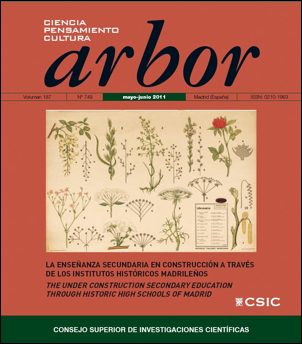Museumization of the Educational Heritage of the Historic High School of Madrid. Proposals for a Virtual Museum
DOI:
https://doi.org/10.3989/arbor.2011.749n3010Keywords:
Secondary education, heritage, museology-scientific collections, virtual museumAbstract
Museums had a remarkable upswing in recent years, due to the renewal of the languages employed in exhibitions, now orientated towards the public, and developing all types of educational activities related to heritage. The oldest secondary schools in Madrid have a valuable educational and historical heritage, consisting of laboratory scientific instruments; zoological, botanical and mineral collections; illustrations, maps and epidiascope plates; legal documents, school records and academic planning; textbooks, and educational media, among others, which require conservation actions and subsequent public exposure. This article presents some theoretical premises in the context of current museum study theories called New Museology and Critical Museology. Furthermore, we suggest a series of instrumental criteria for the building of a virtual educational museum with educational and diffusion purposes.
Downloads
References
Alonso Fernández, L. (2003): Introducción a la nueva Museología, Madrid, Alianza Editorial.
Carreño, M. (2007): “Museología y Museografía de la Educación”, en Escolano Benito, A. (ed.), La cultura material de la escuela. En el centenario de la Junta para la Ampliación de Estudios 1907- 2007, Berlanga del Duero (Soria), CEINCE, pp. 92-111.
Escolano, A. (2000): “La historia de la educación después de la posmodernidad”, en Ruiz Berrio, Julio, La cultura escolar de Europa. Tendencias históricas emergentes, Madrid, Biblioteca Nueva.
Domínguez, C.; Estepa, J. y Cuenca, J. M. (eds.) (1999): El museo, un espacio para el aprendizaje, Huelva, Universidad de Huelva.
Hooper-Greenhill, E. (1998): Los museos y sus visitantes, Gijón, TREA.
Karp, C. (2004): “Digital Heritage in Digital Museums”, Museum International, n.os 221-222, pp. 45-51.
Layuno Rosas, M. (2002): Los nuevos museos en España, Madrid, Edilupa.
Lorente, J. P. y Almazán, D. (eds.) (2003): Museología crítica y arte contemporáneo, Zaragoza, Prensas Universitarias de Zaragoza.
Montero, J. (2006): “Pedagogía crítica y educación en museos. Marcos para una educación artística desde las comunidades”, en Fernández, O. y Río, V. del (eds.), Estrategias críticas para una práctica educativa en el arte contemporáneo, Obra Social de Caja España, 2006, disponible en: http://museoph.org/MuseoPatioHerreriano/publicaciones/estrategias
Ossenbach Sauter, G. y Somoza Rodríguez, M. (2010): “Los museos pedagógicos virtuales y la Historia de la Educación. Posibilidades y desafíos”, en Ruiz Berrio, J., El patrimonio histórico-educativo. Alternativas para su estudio, Madrid (en prensa).
Padró, C. (2003): “La museología crítica como una forma de reflexionar sobre los museos como zonas de conflicto e intercambio”, en Lorente, J. y Almazán, D. (eds.), Museología crítica y arte contemporáneo, Zaragoza, Prensas Universitarias de Zaragoza, pp. 51-70.
Ruiz Berrio, J. (2006): “Historia y Museología de la Educación. Despegue y reconversión de los Museos Pedagógicos”, Historia de la Educación, n.º 25, 2006, pp. 271-290.
Santacana Mestre, J. y Hernández Cardona, F. (2006): Museología crítica, Gijón, Trea, 2006.
Sanz Fernández, F. (2006): El aprendizaje fuera de la escuela, Madrid, Edic. Académicas.
Viñao, A. (2002): Sistemas educativos, culturas escolares y reformas, Morata, Madrid.
Yanes Cabrera, C. (2007): “Pedagogical Museums and the safeguarding of an Intangible Educational Heritage. Didactic Practices and Possibilities”, Journal of Research in Teacher Education, 4, pp. 67-80.
Downloads
Published
How to Cite
Issue
Section
License
Copyright (c) 2011 Consejo Superior de Investigaciones Científicas (CSIC)

This work is licensed under a Creative Commons Attribution 4.0 International License.
© CSIC. Manuscripts published in both the printed and online versions of this Journal are the property of Consejo Superior de Investigaciones Científicas, and quoting this source is a requirement for any partial or full reproduction.
All contents of this electronic edition, except where otherwise noted, are distributed under a “Creative Commons Attribution 4.0 International” (CC BY 4.0) License. You may read the basic information and the legal text of the license. The indication of the CC BY 4.0 License must be expressly stated in this way when necessary.
Self-archiving in repositories, personal webpages or similar, of any version other than the published by the Editor, is not allowed.














